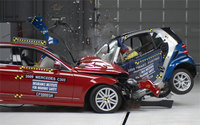IIHS: Size Counts When You Are Not Having Fun, Recommends - Bigger Cars With Equal MPG
- MORE: Complete IIHS Status Report
- MORE: Crash Test Video
- MORE:2009
Coupes With 24+City/Hwy MPG Ranked By Curb Weight
- MORE: 2009 Sedans With 24+City/Hwy MPG Ranked By Curb Weight
- MORE: 2009 Wagons With 24+City/Hwy MPG Ranked By Curb Weight
Auto Central April 14, 2009; In response to the latest IIHS crash tests report, The Auto Channel is providing new and used car shoppers with an exclusive tool that allows them to easily rank potential vehicle purchases by MPG and Curb Weight, as well as 100 other criteria. (See Above).
The IIHS reported that the death rate in 1-3-year-old minicars in multiple-vehicle crashes during 2007 was almost twice as high as the rate in very large cars.
"Size and weight affect injury likelihood in all kinds of crashes. In a collision involving two vehicles that differ in size and weight, the people in the smaller, lighter vehicle will be at a disadvantage. The bigger, heavier vehicle will push the smaller, lighter one backward during the impact. This means there will be less force on the occupants of the heavier vehicle and more on the people in the lighter vehicle. Greater force means greater risk, so the likelihood of injury goes up in the smaller, lighter vehicle."
"Though much safer than they were a few years ago, minicars as a group do a comparatively poor job of protecting people in crashes, simply because they're smaller and lighter," Lund says. "In collisions with bigger vehicles, the forces acting on the smaller ones are higher, and there's less distance from the front of a small car to the occupant compartment to 'ride down' the impact. These and other factors increase injury likelihood."
The death rate per million 1-3-year-old minis in single-vehicle crashes during 2007 was 35 compared with 11 per million for very large cars. Even in midsize cars, the death rate in single-vehicle crashes was 17 percent lower than in minicars. The lower death rate is because many objects that vehicles hit aren't solid, and vehicles that are big and heavy have a better chance of moving or deforming the objects they strike. This dissipates some of the energy of the impact.
Some proponents of mini and small cars claim they're as safe as bigger, heavier cars. But the claims don't hold up. For example, there's a claim that the addition of safety features to the smallest cars in recent years reduces injury risk, and this is true as far as it goes. Airbags, advanced belts, electronic stability control, and other features are helping. They've been added to cars of all sizes, though, so the smallest cars still don't match the bigger cars in terms of occupant protection.
Would hazards be reduced if all passenger vehicles were as small as the smallest ones? This would help in vehicle-to-vehicle crashes, but occupants of smaller cars are at increased risk in all kinds of crashes, not just ones with heavier vehicles. Almost half of all crash deaths in minicars occur in single-vehicle crashes, and these deaths wouldn't be reduced if all cars became smaller and lighter. In fact, the result would be to afford less occupant protection fleetwide in single-vehicle crashes.



